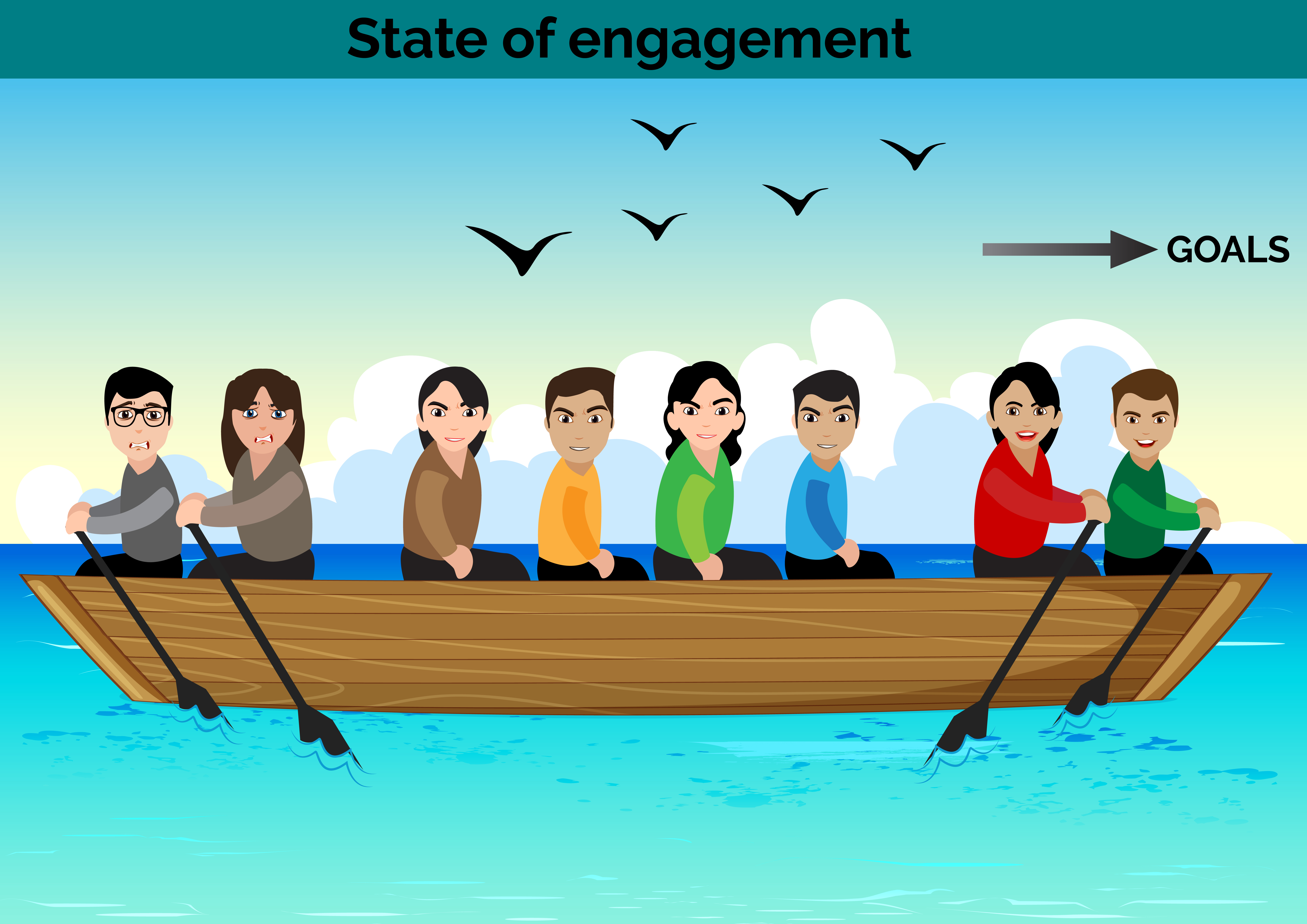[series_meta]
Over two-thirds of employees worldwide are not engaged. At the same time, the subjects ranks high on the priority lists of CEOs worldwide. So, while organizations feel that employee engagement matters, they are not very successful in achieving it. Yet in this fast changing world of high complexity and hyper-competition it is a highly engaged workforce that makes the difference between a struggle for relevance and a thriving future.
In part I of this this article we will get into the current status of employee engagement, we will explore the significance of engagement for your organization, and we will expplain why traditional motivation programs do not work.
In part II we will show you how to shift gears on employee engagement, and create a highly engaging environment.
This article is part of a series
[series_post_list_box]
What can you expect from this article?
- The facts on the state of engagement in organizations worldwide
- What is engagement exactly?
- Why do traditional HR engagement programs not work?
- How to create a successful approach to improving engagement?
Engagement: The hard facts
Only 13% of employees worldwide are engaged, according to Gallup’s 2011/2012 State of the global workplace study¹. Yes, that is correct: 13%! A whopping 63% are not engaged, and a further 24% of the employees are even actively disengaged. These are quite shocking numbers, don’t you think?
I often depict the organization as a boat rowing towards fulfilling its purpose. There’s a small contingent of rowers that is actively rowing, motivated to reach the goals, chanting songs to stimulate others to contribute. But then the bulk of the crew, 63% percent, is not motivated. Sure, they are rowing occasionally, they do contribute, making the occasional splash in the water. But their heart is not in it. They are not going the extra mile. They do not get extra energy to invest when they beat the competition or when they see a promising direction to pursue. And then there is a third contingent of rowers, nearly one quarter of the total crew, who are really unhappy and feel unproductive. They spread a negative ambiance that might easily affect the majority of not engaged employees. This group is actually rowing in the opposite direction! Now how fast do you think your organization is moving this way?
The vast majority of employees who feel not engaged or even actively disengaged state that their current job does not bring out their most creative ideas². And creative ideas happen to be exactly what we need to remain relevant. In an era where long-term sustainable competitive advantages no longer seems to hold, we need to be constantly on the lookout for the next great business model. And the best way to do that is to explore many ideas. A complex environment requires creativity, the ability to think out of the box and come up with ideas that on the outside might seem crazy at first. Fishing in familiar waters will not bring us disruptive innovation. So if disengaged employees feel their work environment does not stimulate their creativity, it becomes clear what positive effect we can expect if we successfully enhance engagement.
The cost of non-engagement
It it is hard to measure the actual cost of lack of engagement. But there are some indicators we can use. We already discussed the lack of creativity in a disengaged workplace. There’s a huge lost opportunity cost involved in failing to unleash the potential creativity that many talented employees in our organization have.
Many managers claim you have to control workers to get them to perform their tasks well. But reality is that once you start controlling people and checking upon them, you will need to do it forever. Because people will merely do what they are told and no more. And you cannot blame them. Why should they? As a result, we have more managers than ever in our organizations. And, I don’t mean this disrespectfully, they do not directly create value to the customer but do consume a disproportionate part of the salary budget.
There’s a lost opportunity cost in people not going the extra mile which is hard to measure but this doesn’t make it any less true. An indirect way of measuring it might be customer satisfaction. One study reports that 73% of customers who abandoned a company attributed it to an indifferent or bad attitude from customer service employees3.
Another way of measuring the cost of disengagement is to look at negative side-effects of which the most important seems to be work related stress. The perceived control an employee has over his own work influences stress levels. The higher the perceived control, the lower the stress. Studies estimated the cost of stress-related absenteeism, lost productivity, and health expenditures to be between 150 and 300 billion a year in the US alone4. Gallup5 found that an actively disengaged employee costs their organization $3,400 for every $10,000 of salary, or 34 percent.
Organizations with engaged employees simply perform better
There’s an increasing number of studies that show that organizations with a high percentage of engaged employees simply perform better. According to another Gallup study6, business/work units scoring in the top half on employee engagement nearly double their odds of success compared with those in the bottom half. Gallup further reports that engaged employees are 17% more productive; highly engaged organizations have a 20% higher sales compared to disengaged organizations; and they are 21% more profitable. Although the advantages of high engagement are just as difficult to measure as the cost of disengagement, it is clear the stakes are high.
Engagement is on the CEO’s priority list
Business leaders know the importance of employee engagement. For many CEOs it is on top of their priority list. The Conference Board CEO Challenge survey, 2014 edition ranked Human Capital as the number one challenge. As an actual strategy to deal with this challenge, employee engagement is ranking higher every year. Yet, despite the attention, not a lot seems to have changed. Yes, the percentage of engaged employees has risen from 11% to 13% from the 2009/2010 edition of the Gallup study to the 2011/2012 edition. And the number of actively disengaged employees had dropped from 27% to 24% globally. But that doesn’t seem very impressive for a challenge that ranks so high on the priority list of business leaders.
Engagement infographic
What is engagement?
Here’s one definition of engagement we found:
Employee engagement is a heightened emotional and intellectual connection that an employee has for his/her job, organization, manager, or co-workers, that, in turn, influences him/her to apply additional discretionary effort to his/her work7.
This definition is a bit more revealing as it mentions the willingness to spend discretionary time to one’s work. But it doesn’t explain why. It is also still vague. Everybody who does their utmost best is engaged? Surely we would have had higher engagement levels then.
Engagement vs Compliance
A better way to look at engagement is to compare it to compliance. Most organizations have compliant employees. I can tell you, some of them might be fairly satisfied when you ask them in an employee satisfaction survey, but for sure they are not engaged. Now, compliance comes in several levels:
Non-compliance
At the bottom we have non-compliance, which is the actively disengaged group we saw at the Gallup studies.
grudging compliant
The lowest level of compliance is what we call grudging compliant8: people do what they are told because they dislike the potential consequences of not obeying more than they dislike the instructions given. Surely these people are not engaged.
Good soldier
One step up the ladder we find the good soldier. They understand and agree to our goals. They do the work but not much more.
The Enrolled
At the top of the compliance ladder we find the enrolled. They will tell you they support your goals for 100% and will do their utmost best to help achieve the goals. They choose to support the company or department’s goals, hence the term enrolled. Sounds good, right? But yet this is still compliance. Why? What is the tipping point between Compliance and Engagement? Can you guess?
Adapted from The Fifth Discipline, Peter Senge
In compliance, at all levels, employees are talking about somebody else’s goals. The goals of the company, the department, or their manager.
When they are engaged, the company goals actually become their own. Engaged employees aligned their own goals with those of the organization. It is not a matter of being satisfied with work, not even a matter of being motivated to do their best. Most professionals do their best… because they are professionals. But that doesn’t make them engaged. This is actually the big group in the middle of not engaged employees, neither engaged, nor actively disengaged.
Can you imagine what it can do for the organization if people go the extra mile, not because they are told to, not because they agree with the goals, but because they choose to because they are in fact pursuing their own goals? This is when the magic happens…
“An engaged employee aligns his/her own goals with those of the organization”
Engagement and the Adaptive Organization
Engagement is important for any organization. As we have seen research points out that organizations with a high level of engaged employees simply perform better. But for the Adaptive Organization, or any organization that is inspired by similar principles, a high level of engagement is crucial. The adaptive organization decentralizes radically and pushes information down to where the information is, usually the front-line workers. Giving them autonomy might boost engagement, but we also really need engagement to make autonomy work. If we provide an environment where people are free to act, and they are really motivated and aligned to the larger goals of the organization, amazing things can happen. If we simply give people freedom without establishing alignment of goals or proper engagement, we might get the chaos that some managers are afraid of with decentralization and empowerment of employees. People either do not move at all, or they act in their own interest. One instrument to get such alignment of goals, as we shall see, is the creation of a common purpose and a set of core values.
The story of the janitor at Favi
One true story about engagement that just sums it all up is the story of the janitor at the French company Favi that has become quite famous by now since it was covered in at least two bestseller books: Freedom Inc. By Brian M. Carney and Isaac Getz, and Reinventing Organizations by Frederic Laloux.
The story is about Christine, a night janitor at Favi, who took a call in the evening because there was nobody else present to take the call. It turned out to be a client who just landed at the airport and expected to be picked up. Christine didn’t know this was actually an auditor from Fiat, an important new customer. But she arranged a pickup spot and time and hung up.
The next morning Favi’s CEO Zobrist was surprised to see the visitor waiting for him in his office, because he had waited for him the previous day until 19:00 and then went home, expecting something had come up. The visitor explained that he could only call after he landed and was pleasantly surprised that someone answered the phone when he called the office the previous night. A woman had picked him up from the airport and drove him to his hotel.
It took Zobrist some time to find out who the mystery chauffeur was. As it turned out, Christine just took the keys of a company car, picked up the visitor from the airport, drove him to his hotel, and then went back to the office to finish her work hours later. Also, she didn’t even feel the need to tell anybody what she did. As far as she was concerned a customer was expecting to be picked up at the airport, an obligation made by the company that only she could fulfill at the moment. And she didn’t expect any praise for it either because for her it was just the right thing to do. As Zobrist put it: She is not a janitor. She is the company.
Source: T.M. Amabile. Harvard Business Review Oct. 1998
The Adaptive Organization thrives in complexity. In a complex system upfront plans and forecasts do not work well. It is full of unknown-unknowns: things we do not know, but what’s worse: we are not even aware we do not know them. If we were, we could just call in an expert. Dealing with the unknown-unknown does not call for experts, but for creatives who feel comfortable in uncertainty, who can think out of the box.
Motivation, and therefore engagement, is an important component of creativity. Engagement is important to unleash the creativity in our employees we need in today’s complex world.
Why HR Motivation programs don’t work
Here’s the thing, straight at you: typical HR motivation programs do not work. It all starts with a survey that is supposed to be voluntary. Because if you force people you get skewed results. We all know that, right? But HR wants a high number of responses so they talk to the department managers to convince them of the importance of the survey and make them talk to their team members to convince them of the importance. Or they use incentives to stimulate the number of responses.
HR then uses the results to create a motivational program, complete with motivational posters and t-shirts. The program typically has two parts: in the first part, people are told what the goals of the organization are and why they are important. The second part usually is some kind of incentive program: rewards and other perks people can get when they achieve the goals.
The goal of the program is to motivate people. And that is exactly the reason why they don’t work. You cannot motivate people. People motivate themselves. Actually, people are usually already motivated, but we create a work environment that sucks all the motivation away. And then we create a program to compensate for that.
But the program does not really change anything that stands in the way of self-motivation. We still tell people what the goals are instead of involving them in defining the goals. We don’t really care about their goals, we just want to motivate them to achieve ours. We do not really give them the freedom to organize the work the way they deem fit. We don’t allow them to master skills other than the ones we define for them. And then we bribe them with tangible rewards and perks to work hard to achieve our goals. This is what we call extrinsic motivation: rewards, or punishment for that matter. Carrots and sticks. They just do not work the way you intend though. They might have an effect. Dan Pink explains that as long as tasks are simple and short-term, extrinsic motivation works to get results. But that does not mean it gets you engagement. People act because they want to have the reward. Not because they care about the work. That is compliance. Not engagement. Engagement is about intrinsic motivation, motivation that comes from within employees themselves.
“You cannot motivate employees. They motivate themselves.”
But isn’t it at least nice to show appreciation when employees contribute to the company goals in the form of a reward? The thing is it is the wrong message. You are rewarding people for doing the right thing. You are rewarding them for what should be default behavior. Remember the janitor, Christine, at Favi’s? She did not get a reward for her outstanding work to help out the customer stranded at the airport nor did she expect to be rewarded. Why? Because for her it was the right thing to do. It was not special, it was default. You don’t have to reward people extrinsically, you just have to allow them to align their goals to yours and then make the right decisions.
Conclusion
Employee engagement is shockingly low worldwide. Although hard to calculate exactly, it is easy to see how it is costing organizations a tremendous amount of money in lost opportunity costs, dissatisfied customers because of poor customer service, employee turnover, and mental healthcare.
Improving engagement is high on the agenda of CEOs but until they are prepared to make fundamental changes in the way we structure and manage organizations, not much will change. It is striking that we still more or less use the same organization model as in the beginning of the industrial revolution which at the time already gave birth to the first strikes and worker riots.
In part II of this article we are going to explore how to build an environment that improves and nourishes engagement, by supporting fundamental psychological human needs.
Follow this article
You can choose to follow this article in which case you will be notified when there there are updates of the article. You can also choose to follow all articles of this category. You will then be notified if a new article is added in this category.
Bibliography
List of notes and sources we reference from.
Notes
- Worldwide, 13% of Employees Are Engaged at Work, https://news.gallup.com/poll/165269/worldwide-employees-engaged-work.aspx
- Gallup Study: Enaged Employees Inspire Company Innovation, The Gallup Management Journal, October 12, 2006, http://gmj.gallup.com + Carney, Brian M. and Getz, Isaac. (2009). Freedom Inc. Domme Valley House. Page 37.
- Carney, Brian M. and Getz, Isaac. (2009). Freedom Inc. Domme Valley House. Page 37.Original source: “Churn: how to reduce customer abandonment”, The Marketing Intelligence Review, no. 6, December 2005.
- Carney, Brian M. and Getz, Isaac. (2009). Freedom Inc. Domme Valley House. Page 42.
- How to Calculate the Cost of Employee Disengagement, Paul Petrone. https://learning.linkedin.com/blog/engaging-your-workforce/how-to-calculate-the-cost-of-employee-disengagement
- The relationship between engagement at work and organizational outcomes, Gallup. 2012. https://employeeengagement.com/wp-content/uploads/2013/04/2012-Q12-Meta-Analysis-Research-Paper.pdf
- Gibbons, John. M, Employee Engagement: A review of current literature and its complications, The Conference Board, 2006.
- Adapted from Senge, Peter. (1990). The Fifth Discipline. Random House. Page 203.









